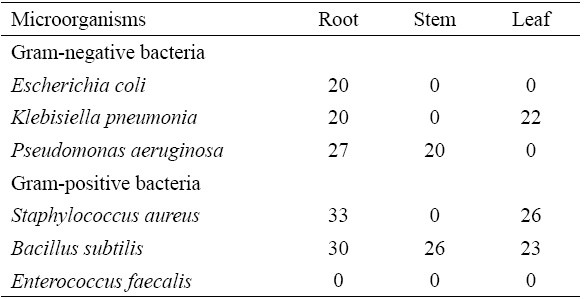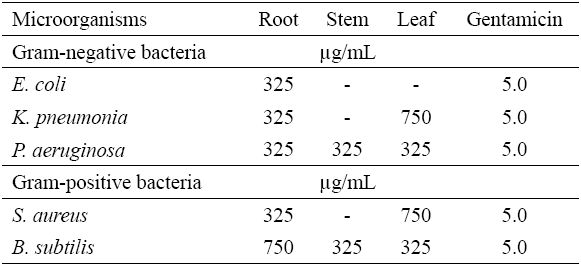Introduction
The Piperaceae family is estimated to contain more than 3.600 species in five genera (Macropiper, Zippelia, Piper, Peperomia and Manekia) widely distributed in tropical and subtropical regions of the world [1]. The genus Piper is the largest one, comprising approximately 2000 species [1]. The Piperaceae family is valued due to its biological, chemical, economic and ecological characteristics, attributed to its secondary metabolites such as alkaloids, lignans, neolignans, amides, chromene, polyketides, phenylpropanoids, prenylated benzoic acid, flavonoids and terpenes [2-3]. In particular, the essential oils obtained from the Piper species are considered important sources of insecticidal compounds, such as phenylpropanoids safrole, eugenol and dillapiole. The Piper species as P. hispidinervium, divaricatum, P. callosum and P. aduncum have been considered as natural sources of safrole with biologic potential [4]. The essential oil of P. divaricatum tissues and safrole were active against bacteria Listeria monocytogenes, Salmonella Typhimurium and Pseudomonas aeruginosa[5]. The essential oil from the P. corcovadensis exhibited a strong oviposition deterrent effect. Even at a concentration of 5 ppm, the oil inhibiting egg laying of pregnant females, and the major constituents of oil identified were 1-butyl-3,4-methylenedioxybenzene and terpinolene [6].
As part of the systematic study of volatile constituents from the Piper species [5,7,8], in the present study, the chemical constituents of essential oils from the Piper caldense (Piperaceae) leaf, root and stem were identified. The P. caldense is known by the popular name “pimenta d’arda” or “pimenta d’água” and commonly used in Brazilian folk medicine for the treatment of snake, sedation and diseases of the stomach [9-10]. So the medicinal proprieties of plant, using the antimicrobial activity of essential oils from P. caldense tissues, were tested. To our knowledge, there are no published reports on the antimicrobial activity and chemical composition of the essential oils from P. caldense tissues.
Results and discussion
Chemical characterization
Results obtained in the present study for the qualitative and quantitative analyses of the essential oils are shown in Table 1. The main classes present in the leaf oil were monoterpene hydrocarbons and sesquiterpene hydrocarbons in a total of 28 compounds, representing 83.4% of the total oil. The leaf oil comprised mainly of α-cardinol (19.0%), α-muurolol (9.0%), tujopsan-2-β-ol (7.4%), δ-cadiene (5.6%), linalool (3.2%), cubenol (3.2%), γ-amorphene (3.1%), α-terpineol (3.0%). Root oil analysis showed 22 volatile compounds, representing 92.0% of the total oil. The major constituents were hydrocarbon pentadecane (35.7%), valencene (10.5%) and elina-3,7-11-diene-α-terpineol (5.4%). An analysis of the essential oil from P. caldense stems identified 20 compounds accounting for 83.2% of the total oil. The main compounds were identified as terpine-4-ol (18.5%), α-terpineol (15.3%), α-cadinol 2-β-ol (9.8%). In the Piper species, the sesquiterpene α-cardinol identified as the major compound in the leaves and roots of P. caldense has been previously reported in P. cernuum and P. dilatatum [11-12].
Antimicrobial activity
The essential oils of P. caldense tissues were tested against three Gram-positive bacteria and three Gram-negative bacteria. The results, presented in Table 2, show that the oil was biologically active against bacteria tested, with inhibition zones ranged from 20 to 33 mm. The most sensitive microorganism was Bacillus subtilis, with inhibition zones of 30, 26 and 23 mm for oils from the root, stem, leaf, respectively. The most effective oil was obtained from the root, showing activity against all bacteria except for resistant Gram-negative bacteria Enterococcus faecalis.
Table 2 Antimicrobial activity of essential oils from the P. caldense root, stem and leaf using disc diffusion assay. Diameter of inhibition zone (mm) Concentration of 20 mg/mL.

All compounds having inhibition diameter zones greater than or equal to 12 mm were selected for MIC (Minimum Inhibitory Concentration). According to the literature criteria [13], the extracts and fractions showing a MIC lower than 100, ranging from 100-500, 500-1000 and over 1000 μg/mL are characterized as potent, moderated, weak and not active, respectively. The essential oils obtained from leaves, stems and roots showed moderate to weak activity with MICs of 325 or 750 μg/mL (Table 3). The antimicrobial activity of leaf and root oils can be attributed, at least in part, to the presence of α-cardinol, considering that α-cardinol is known to present bacteriolytic activity against S. aureus[14].
Studies previous revealed that the essential oil from Piper guineense fruit was active against the gram negative bacteria E. coli and P. aeruginosa, and identified as having as major constituents the terpenes β-pinene (23%), β-caryophyllene (7%), bicyclogermacrene (6%) [15]. The essential oil from P. malacophyllum leaf inhibited growth of Trichophyton mentagrophytes and Cryptococcus neoformans fungi, with (+)-camphor (38%) as the major constituent identified [16]. The essential oil of P. ilheusense leaf was active against the microorganisms S. aureu, E. coli, Candida albicans, C. krusei, and C. parapsilosis, the chemical compositions of the oil consisting only of sesquiterpenes [17].
In summary, the present study indicates that both essential oils from P. caldense tissues showed potential antimicrobial activity; and it was mainly the oil of the roots that was the more active. This is the first report of the biological activities and chemical composition of the essential oil of P. caldense.
Experimental
Plant material
P. caldense leaf, stem and root were collected in Recife, Pernambuco state, northeastern Brazil, in January 2014. Botanical identification was made by Dr. Ângela M. M. Freitas (Department of Forest Sciences - Pernambuco Federal Rural University) and a voucher specimen was deposited in the Sérgio Tavares Herbarium of that university (HTS 18180).
Obtaining and analysis of the essential oils
The essential oils from fresh leaves, roots and stems were obtained by hydrodistillation using a Clevenger-type apparatus. 100 g of fresh plant tissue and 250 mL of H2O were used and the distillation was carried out for 2 h after the mixture reached boiling. Traces of water present in the essential oils were removed by treatment with Na2SO4. The samples were kept at -20 oC in a freezer until further analysis. Yields were calculated from weight of fresh material. The essential oils were analyzed by GC-MS (60-240 ºC at 3 ºC min. rate) in a Shimadzu GCMS-QP5050A instrument using fused-silica capillary column (30 m × 0.25 mm i.d. × 0.25 μm.) coated with DB-5. MS spectra were obtained using electron impact at 70 eV with a scan interval of 0.5 s and fragments from 40 to 550 Da (all the samples were analyzed in triplicate).
Quantitative analysis of the chemical constituents was performed by flaming ionization gas chromatography (FID), using a Perkin-Elmer instrument, under the same conditions and with the same column as reported for the GC-MS. Identification of the components was based on GC retention indices with reference to a homologous series of C7-C30 n-alkanes calculated using the Van den Dool & Kratz [18] equation and by computer matching against the mass spectral library of the GC-MS data system (NIST 98 and Wiley) as well as other published mass spectra [19].
In vitro assay for antimicrobial activity
The antimicrobial activities of essential oils from the P. caldense leaf, stem and root were tested against the following microorganisms: Gram-positive bacteria: S. aureus (ATCC 6538), B. subtilis (ATCC 6633) and E. faecalis (ATCC 6057); Gram-negative bacteria: E. coli (ATCC 25922), K. pneumoniae (ATCC29665) and P. aeruginosa (ATCC by the Antibiotics Department of Pernambuco Federal University (UFPEDA) and maintained in nutrient agar (NA), stored at 4 °C. The antibacterial activity was reported preliminarily utilizing the disc diffusion method. In this method, disks containing known amounts of an antimicrobial agent were placed on the surface of an agar plate that had been inoculated with a standardized suspension of each microorganism tested. Paper discs with only ethanol were used as negative controls. All experiments were carried out three times and repeated if the results differed. A stock solution (10 mg/mL) of each test sample was prepared in ethanol as the solvent. Furthermore, the serial dilution of the test compounds was carried out and the concentrations used ranged from 2500 to 19.5 µg/mL. Test samples at various concentrations were added to culture media in test tubes. All strains were provided different strains were inoculated at 108 bacteria/mL concentration. Tryptic soy agar and nutrient agar were utilized as culture media. The tubes were incubated at 37 °C for 24-48 h and then examined for the presence or absence of growth of the organisms. The MIC values were obtained from the lowest concentration of the test samples where the tubes remained clear, indicating that the bacterial growth was completely inhibited at this concentration. Gentamicin was used as antibacterial substance.











 nueva página del texto (beta)
nueva página del texto (beta)




